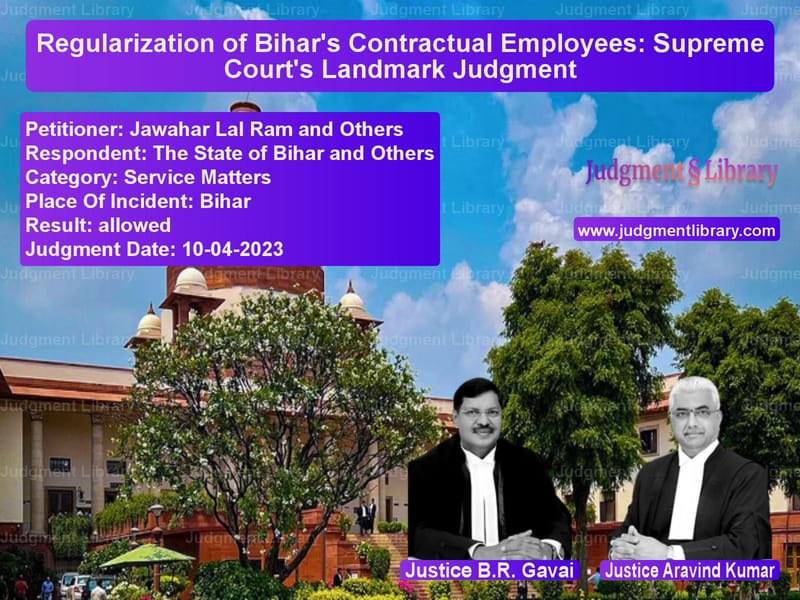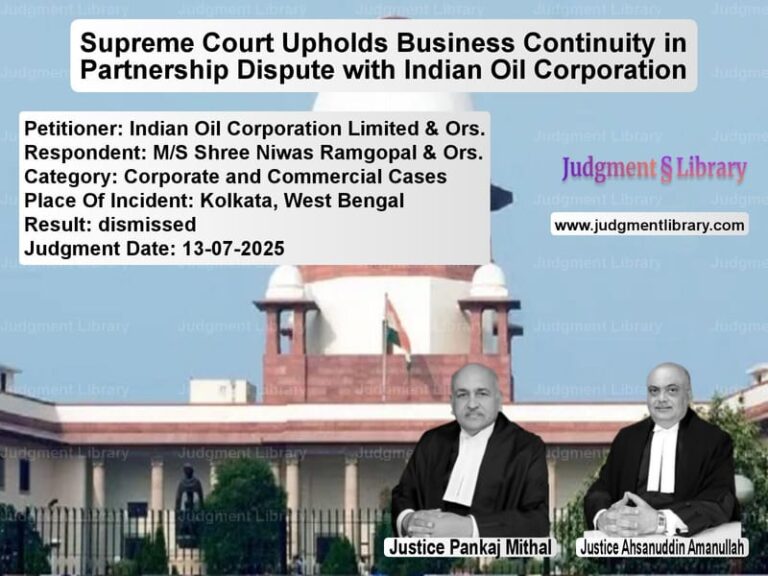Regularization of Bihar’s Contractual Employees: Supreme Court’s Landmark Judgment
The Supreme Court of India recently delivered a significant judgment in the case of The State of Bihar & Others vs. Jawahar Lal Ram & Others. This case revolved around the employment rights of contractual workers initially engaged by a private contractor but later appointed to sanctioned posts in the Bihar Intermediate Education Council (BIEC). The core issue was whether these employees should be absorbed into regular government service after years of continuous employment.
The ruling is crucial as it addresses a long-standing issue concerning contractual employees working under various state government agencies. The court, using its extraordinary powers under Article 142 of the Constitution, ordered the absorption of these employees while denying them back wages. This judgment highlights the importance of procedural fairness, adherence to legal employment norms, and the recognition of long-term service contributions.
Background of the Case
The case involves employees who initially worked under a private contractor, N.I.C.T. Computing System Private Limited, which was hired for computerization work at the Bihar Intermediate Education Council (BIEC). These employees worked at the BIEC from 1999 to 2005 as part of the contractor’s workforce.
Following the termination of the contract between N.I.C.T. and BIEC in 2005, the Chairman of the Council appointed these employees to newly sanctioned posts within BIEC. Subsequently, in 2007, the Bihar government enacted the Bihar Intermediate Education Council (Repeal) Act, leading to the merger of BIEC with the Bihar School Examination Board (BSEB). As a result, these employees were declared surplus, and a scheme for their absorption was framed in 2012.
However, despite continued employment, the services of these employees were terminated in 2017, leading to a legal battle for their reinstatement and regularization.
Arguments of the Petitioners
The petitioners, represented by senior counsel Shri Dinesh Dwivedi, argued:
- They had been continuously working since 1999, including service under the BIEC from 2005 to 2017.
- Their termination in 2017 violated the 2012 government scheme formulated for employee absorption.
- The Division Bench of the High Court, in an earlier round of litigation, found that the petitioners met all four conditions necessary for regularization.
- Uprooting them after nearly two decades of service would be unfair and detrimental to their financial stability.
Arguments of the Respondents
The State of Bihar, represented by senior counsel Shri Shyam Divan, presented the following counterarguments:
- The Division Bench of the High Court erroneously overruled the Single Judge’s well-reasoned order, which found that the petitioners did not meet the necessary conditions for absorption.
- The report of the committee formed to assess employee absorption was signed by only one member instead of all three, rendering its findings procedurally flawed.
- Accepting the petitioners’ plea would set an unsustainable precedent for contractual employees seeking automatic regularization.
- Reinstating these employees would disrupt the state’s hiring and employment policies.
Supreme Court’s Key Observations
The Supreme Court carefully examined the facts and found that:
- “The petitioners have been continuously working since 1999, much before the landmark judgment in Secretary, State of Karnataka and Ors. v. Uma Devi (3), which was delivered on April 10, 2006.”
- “Uprooting the writ petitioners at this stage of life would have devastating effects on them as well as their families.”
- “In the present case, taking into consideration the peculiar facts and circumstances and without treating this as a precedent, a relief needs to be molded to do complete justice.”
- “The Division Bench’s reasoning, which focused primarily on procedural issues, failed to consider the substantive rights of the employees.”
Final Judgment
The Supreme Court exercised its extraordinary powers under Article 142 of the Constitution to ensure justice. The Court ordered:
- All petitioners should be absorbed into their respective posts from May 1, 2023.
- The petitioners would receive full continuity in service for all benefits, including retirement benefits.
- However, no back wages would be granted for the period when they were out of employment.
Implications of the Judgment
This ruling has significant implications for contractual employees working in government institutions across India:
- Recognition of Long-Term Service: The judgment acknowledges that employees who serve for decades, even in contractual roles, deserve fair treatment and job security.
- Limited Precedent Value: The Court emphasized that this decision was based on unique facts and should not be interpreted as a blanket ruling for all contractual workers seeking regularization.
- Judicial Intervention in Employment Matters: By using Article 142, the Supreme Court reaffirmed its ability to provide complete justice in exceptional circumstances.
Conclusion
The Supreme Court’s decision in this case ensures that long-serving employees receive fair treatment without fundamentally altering government hiring policies. By striking a balance between protecting workers’ rights and maintaining employment regulations, the ruling sets an important precedent in labor law jurisprudence.
Petitioner Name: Jawahar Lal Ram and Others.Respondent Name: The State of Bihar and Others.Judgment By: Justice B.R. Gavai, Justice Aravind Kumar.Place Of Incident: Bihar.Judgment Date: 10-04-2023.
Don’t miss out on the full details! Download the complete judgment in PDF format below and gain valuable insights instantly!
Download Judgment: jawahar-lal-ram-and-vs-the-state-of-bihar-a-supreme-court-of-india-judgment-dated-10-04-2023.pdf
Directly Download Judgment: Directly download this Judgment
See all petitions in Employment Disputes
See all petitions in Public Sector Employees
See all petitions in Termination Cases
See all petitions in Judgment by B R Gavai
See all petitions in Judgment by Aravind Kumar
See all petitions in allowed
See all petitions in supreme court of India judgments April 2023
See all petitions in 2023 judgments
See all posts in Service Matters Category
See all allowed petitions in Service Matters Category
See all Dismissed petitions in Service Matters Category
See all partially allowed petitions in Service Matters Category







